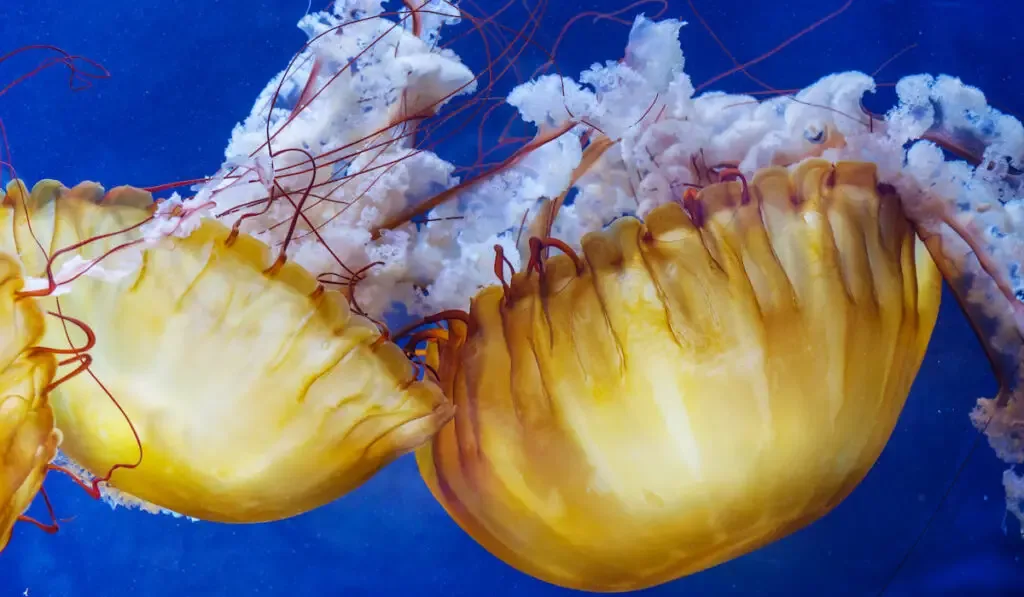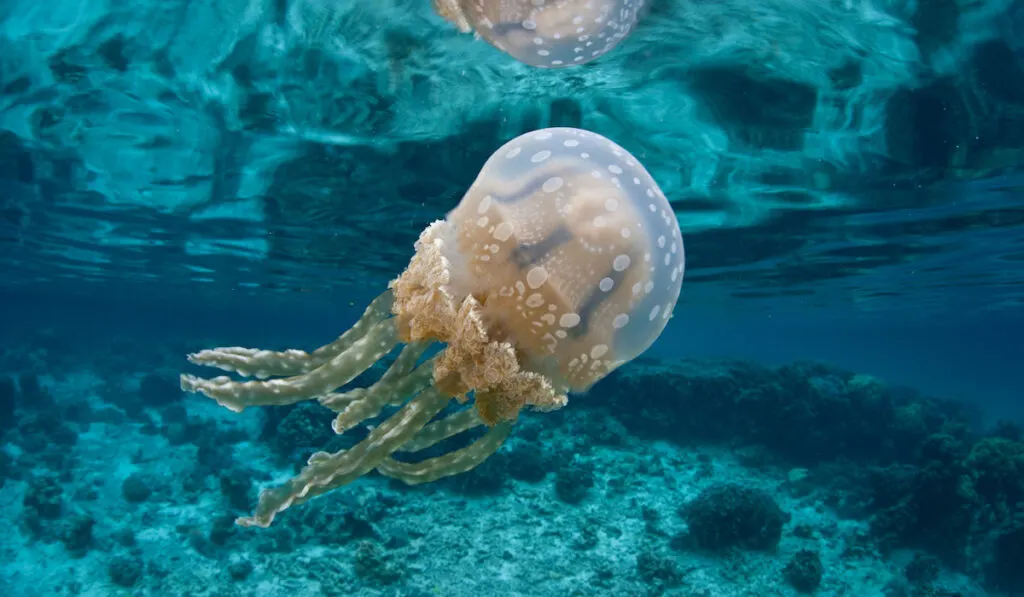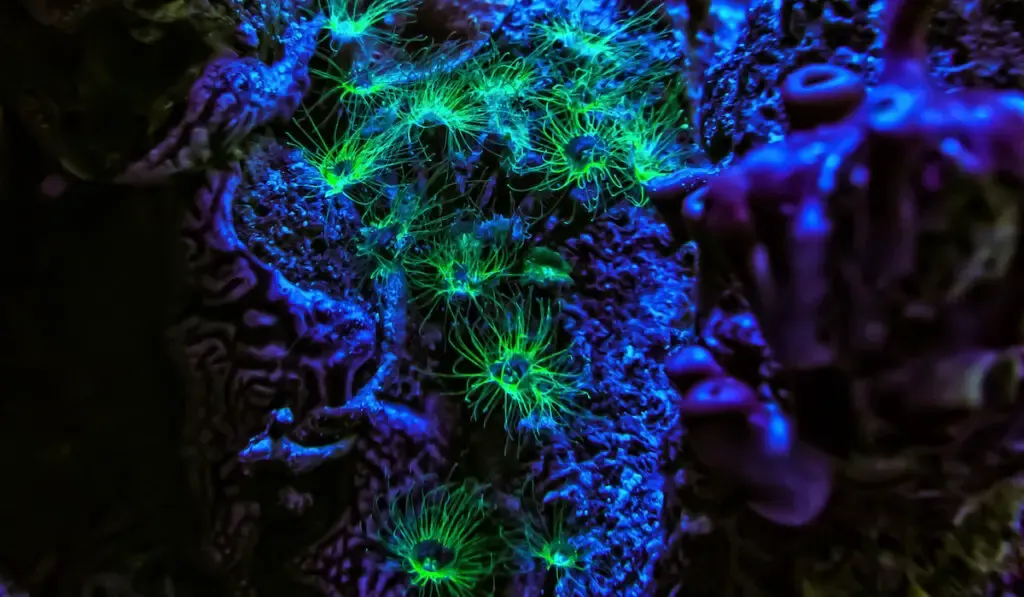Have you ever seen a jellyfish? Jellyfish are fun to watch because they are so unique looking with long tentacles and different kinds of movement. But they look completely different from most other animals with the word fish in their name.
Is a jellyfish a fish?
Jellyfish are not actual fish despite their name. They are marine animals that are classified differently due to their own physical characteristics.

While they are not be fish, jellyfish are interesting animals to learn about. Let’s take a closer look at jellyfish, why they are not true fish, and some interesting facts.
Table of Contents
What is a Jellyfish?
Jellyfish are the medusa phase of certain animals in the phylum Cnidaria. This phylum includes a unique assortment along with corals and sea anemones
If you observe sea anemones closely, they look like upside-down jellyfish. This is because in the phylum Cnidaria, not all animal species in their sedentary phase (called the polyp phase) grow into the free-swimming phase (medusa phase).
Jellyfish are known for their umbrella-like bodies and tentacles. You may also know that their tentacles can sting other animals including humans.
Why Are Jellyfish Not Considered Fish?
A fish is any aquatic vertebrate that breathes using gills and makes use of fins (rather than digits).
Jellyfish do not have a bone structure gills and they take in oxygen by absorbing it through the water, rather than through gills.
Jellyfish Ecology: What They Eat and What Eats Them
Most jellyfish species are carnivorous. Here are some examples of organisms that jellyfishes eat:
- Small fish
- Plankton
- Crustaceans
- Fish eggs and larvae
- Other jellyfish
Spotted jellyfish (Mastigias papua) can receive energy from Zooxanthellae algae through photosynthesis. This type of algae form a symbiotic relationship with corals and other marine animals.

Despite their various defense mechanisms, jellyfish can still fall victim to predators. Here are some animals that commonly eat jellyfish:
- Tuna
- Sharks
- Penguins
- Swordfish
- Sea turtles
Jellyfish Lifecycle
Jellyfish go through a lifecycle in three distinct development stages: planula, polyp, and medusa. In each stage, jellyfish take on different attributes and abilities that allow them to grow and adapt to their environment.
1. Planula (Larvae)
The planula is a planktonic (drifting) phase. The jellyfish are in a larva form covered with cilia. When the planula has developed and drifts to a firm surface, it will attach itself to the surface (known as substrate).
2. Polyp

In the polyp phase, the jellyfish with attach itself to the firm substrate. This allows it to develop further in a (hopefully) stable environment.
3. Medusa
When the polyp has developed, it detaches itself from the substrate and swims away. This free-swimming phase is called the medusa phase.
The medusa phase is also the sexual phase for jellyfish. They release sperm and eggs into the water. When an egg becomes fertilized, it becomes a planula and the lifecycle repeats.
Can You Eat Jellyfish?
There are many jellyfish species safe for you to eat. Since jellyfish are consumed in their medusa phase (able to reproduce and closer to the end of their lifecycle), they are considered a sustainable food source.
While jellyfish can be a unique dining experience, they are not commonly consumed in western culture. They are, however, considered a delicacy in many Asian countries. Jellyfish are not particularly nutritious but can add interesting flavor and texture to a number of dishes.
The following table shows the nutritional composition of 2 edible jellyfish species:
| Nutrient | Malaysian Jellyfish | Cannonball Jellyfish |
| Fat | <0.01 g | <0.01 g |
| Ash | 0.69 g | 0.33 g |
| Protein | 4.13 6 | 4.69 g |
| Calories | 16.52 Kcal | 17.84 Kcal |
| Moisture | 95.63 g | 95.04 g |
10 Interesting Jellyfish Facts
1. There Is an Immortal Jellyfish Species

Remember that polyps grow to become medusa? A jellyfish species called Turritopsis dohrnii can be immortal because it has the ability to become a polyp once again after reaching the medusa phase.
Though this behavior only been seen in labs, the Turritopsis dohrnii can teach scientists about age reversal.
2. One Jellyfish Is the Most Lethal Marine Organism
The Box Jellyfish can kill with its sting in less than one minute. This very small jellyfish is the most venomous marine species.
3. Jellyfishes Have Been to Space
Scientists sent 2,000 jellyfish to space in 1991 to test the effect of zero gravity on their movement.
All of the jellyfish moved freely in the absence of gravity. But when they reproduced and returned to Earth, their offspring were used to an environment without gravity and did not survive for long.
4. Jellyfish Sleep
Even though jellyfish lack a brain or a nervous system, they still need to rest. In fact, jellyfish were one of the first animals without a central nervous system discovered to take advantage of a resting state.
5. Jellyfish Can Stay In Groups
While some species remain mostly alone, many jellyfish varieties live or come together in groups.
What do you call a group of jellyfish? The name depends on the reason the jellyfish are collected together.
- Bloom: Large group resulting from an increase in population
- Smack: Collection in their natural habitat
- Swarm: Gathering due to strong winds and waves
6. Jellyfish Can Emit Their Own Light
Some jellyfish exhibit bioluminescence. Bioluminescence is the natural production of light in living organisms. In jellyfish, this is caused by a laminating protein.

7. Jellyfish Tentacles Never Tangle
Jellyfish tentacles may look like they can become caught up on one another. But the slime on the tentacles is so slippery that all of tentacles move freely with limited friction, so they never become tangled.
8. Jellyfishes Are Brainless, Lungless, and Heartless
Jellyfish are unique animals because they do not have brains, lungs, or a heart. How can they function without nervous, respiratory, or circulatory systems?
They do not have blood, so they do not need a heart. Their cells collect dissolved oxygen from the water through their semi-permeable membrane, so they do not need lungs. They react to environmental stimuli automatically so they do not need a brain.
Jellyfish, and the rest of the phylum Cnidaria, are primitive animals. Other animals without a brain are:
- Coral
- Sponge
- Starfish
- Hydrozoa
- Sand dollars
9. Jellyfish Are the Oldest Fossils
Jellyfish fossils dating back to more than 500 million years ago have been found, making them the oldest fossils on record (so far). This means that jellyfishes have been on Earth much longer than most animals, and they predate the dinosaurs.
10. Jellyfish Can Reproduce Both Sexually and Asexually
Jellyfish can reproduce asexually by budding in their polyp stage. In fact, a jellyfish can produce more polyps by asexual reproduction than it can create planula as a medusa
Jellyfish also reproduce sexually during the medusa stage by releasing sperm and eggs into the water, creating new planula in the process.
Final Thoughts
Jellyfish are interesting creatures found in the sea. Even though their name includes the word ‘fish’, jellyfish are not fish at all. They are members of their own unique phylum with special characteristics, most notably the lack of bone structure, respiratory system, and nervous system.
